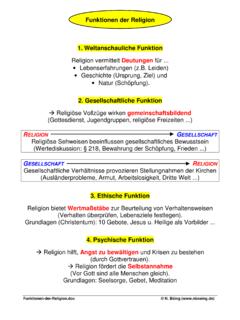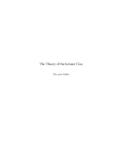Transcription of 2001 The Sampling Issues in Quantitative Research
1 NAN / Okul ncesi retmen Adaylar n n Bilimsel S re Becerilerine li kin Alan 2001 The Sampling Issues in Quantitative ResearchAli DEL CE*AbstractA concern for generalization dominates Quantitative Research . For generalizability and re-peatability, identification of sample size is essential. The present study investigates 90 qu-alitative master s theses submitted for the Primary and Secondary School Science and Mathematics Education Departments, Mathematic Education Discipline in 10 universi-ties in Turkey between 1996 and 2007, in terms of Population and Sample using docu-ment analysis. Coding is used to analyze the data and results are presented by using desc-riptive statistics. Most of the theses were found to include a few lines of information on population and sample, and a few presented the characteristics of the sample in detailed tables, though without any information on the selection criteria were given.
2 Randomiza-tion in random Sampling , which is frequently used, was usually limited to unbiased assign-ment of two classes out of four within a school. No attention was paid to the appropria-teness of the sample size and to the analysis techniques employed. Effect size was calcu-lated in only one dissertation, but was not taken into account in the identification of the sample size. Normality tests also indicated some challenges. The effects of sample size on reliability assessment were not taken into WordsSampling Technique, Sample Size, Effect Size, Mathematics Education, Examining Dis-sertations.**Correspondence: Assist. Prof. Ali DEL CE, Marmara University Faculty of Atat rk Education, Department of Secondary Science and Mathematics Education, Mathematics Education 34722 Kad k y- stanbul/Tur-key. E-mail: ve Uygulamada E itim Bilimleri / Educational Sciences: Theory & Practice10 (4) Autumn 2010 2001-2018 2010 E itim Dan manl ve Ara t rmalar leti im Hizmetleri Tic.
3 Ltd. EDUCATIONAL SCIENCES: THEORY & PRACTICEQ uantitative Research predominantly assumes a positivist world view (Henn, Weinstein & Foard, 2006, p. 27) which are called paradigms and tied to Research techniques firmly (Hughes, 1990, s. 11). Moreover, Guba and Lincoln (1994, s. 105) think that paradigms are superior to methods of enquiry in Research . Quantitative Research paradigm em-phasizes the importance of generalizability and reliability (Henn et al., 2006, p. 16). The aim is to apply the relationship obtained among vari-ables to the general, the population. That is why the selection of a sample representative of the population is essential (Karasar, 1999). Master thesis is one of the first places where scientific studies conducted by provisional academicians. Therefore, analyzing these theses may re-veal weak parts and also develop conducting Research by definite princi-ples such as defining Research techniques and population and Sampling .
4 The Research studies on Turkish theses are usually about their structures. Aksoy and Dilek (2005) investigated the dissertations/theses with re-spect to the order given in contents of the theses and found that title is not reflecting the chapters/sections. T rer (2005) highlights the scien-tific quality of theses and the responsibility of the supervisors for their students to be a researcher. zdemir and Ar (2005) examined 20 theses which are randomly chosen with respect to their topics, contents, and methodologies to reveal what is studied most and what is not. Ramazan, ztuna and Dibek (2005) examined 91 dissertations/theses in terms of sections and their titles whether there is any coherency or not and they found that no criteria used to define population and Sampling of the study. Moreover, they also revealed that researchers misused reliability and validity in their dissertations.
5 Demirel, Ayvaz and K ksal (2005) investigated all doctoral dissertations finished between 1995 and 2005 in terms of their topic and methodologies. They found that researchers prefer to use Quantitative rather than qualitative approaches in their reliability of Research is closely related to its repeatability (Altun k, Co kun, Bayraktaro lu & Y ld r m, 2004). When writing up, the re-searcher should pay special attention to present information about the characteristics of the sample including details on Sampling strategies which would enable others to repeat the Research (Henn et al., 2006, p. 238). Based on the Research findings of U urlu, Delice and Kork-maz (2007) and U urlu and Delice (2008) this study qualitatively ex-amines Quantitative master s theses in mathematics education in terms DEL CE / The Sampling Issues in Quantitative Research 2003of the appropriateness of (1) the characteristics of the population, (2) the Sampling technique used, (3) the size of the sample and selection criteria, and (4) the characteristics of the population and data analysis techniques used.
6 MethodTo investigate Quantitative master theses conducted in Turkey written documents (Robson, 2002, p. 348) are examined by document analyz-ing techniques and using qualitative approaches (Cohen, Manion & Morrison, 2000, p. 102). The most significant difference of document analysis compared to other Research techniques is the analysis of writ-ten documents , which avoids researcher influence on the data as in questionnaires, observations and interviews. Documents are by no means affected by the researcher s inference and are ready resources which could always be revisited. The frequently used techniques into analyze the written documents is content analysis (Robson, 1993, p. 272; Robson, 2002, p. 349). SamplingThe present study evaluates 90 master s level theses submitted for the Primary and Secondary School Science and Mathematics Education Departments, Mathematic Education Discipline of 10 universities in Turkey between 1996 and 2007.
7 The evaluation consists of the Popu-lation and Sampling sections of these theses in terms of the Research population, Sampling technique, sample size, selection rationale and re-lated references with a qualitative perspective which allows a thorough analysis. The distribution of theses in relation to universities and years are presented in Table 1 and 2. Due to the rearrangement of Education Faculties in 1996 (S lay & G k, 2005) theses submitted prior to this date were not included in the analysis. In line with the recommenda-tions of U urlu et al. (2007) only master s theses and again with that of U urlu and Delice (2008) only theses with a Quantitative paradigm were included. Thus, the present Research comprises all Quantitative master s theses in mathematics education which could be accessed via the National Thesis Center1.
8 Therefore, the study employs a purposeful Sampling technique for non-probability Sampling (Patton, 1990).1 Random Sampling was not possible because author permission was yet to be received for many of the dissertations. Again due to the same reason, the number of accessible dissertations might have changed since Sampling Issues in Quantitative Research2004 EDUCATIONAL SCIENCES: THEORY & PRACTICET able 1. Distribution of Theses According to Years19961997199819992000200120022003200 4200520062007 Number of Theses2252108131289163 Table 2. Distribution of Theses According to UniversityUniversityNumber of ThesesBo azi i University18 Middle East Technical University3 Hacettepe University8 Gazi University17 Dokuz Eyl l University9 Marmara University12 Sel uk University11 Erzurum Atat rk University2Y z nc Y l University5 Bal kesir University5 Total90 Data AnalysisThe qualitative data collected by written documents (theses) need to be analyzed to make sense about the situation, noting patterns and catego-ries (Cohen et al.)
9 , 2000, p. 147). Coding is one of the ways to analyze the qualitative data, so that data gathered by theses were categorized in terms of themes relevant to Research aims which are; population, sam-pling technique, sample size, Research design, effect size. Descriptive statistics was utilized to analyze and present the findings. All docu-ments are examined with respect to each theme and then by using main and well known sources from the relevant literature (Baykul, 1999; Co-hen et al., 2000; Karasar, 1999; Patton, 1990) all categorizations are constructed under each theme. Since, in some theses, a section need to be in methodology chapter can be found in some other chapters each dissertation is read from first page to last page to categories the data. DEL CE / The Sampling Issues in Quantitative Research 2005 The reliability of a Research instrument concerns the extent to which the instrument yields the same results on repeated trials by different people.
10 The tendency toward consistency found in repeated measure-ments is referred to as reliability (Miles & Hubberman, 1994). To categories the data main and well known sources from the relevant literature are used and non applicable data are coded as not given or not described to prevent to subjectivity of the researcher. Reli-ability of the Research was calculated almost 100 percent and since it is greater than 90 % consistency was accepted for reliability (Miles & Hubberman, 1994).FindingsThe findings could be grouped as selection of the population , sam-pling technique preferred, sample size on which the Research was conducted, Research design which affects the sample size, effect size , data analysis methods , normality tests and reliability tests especial-ly as part of data analysis methods and references.


















